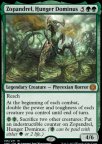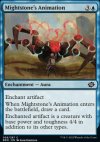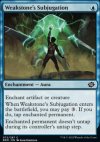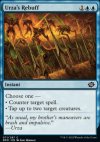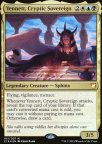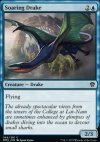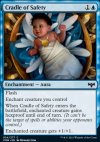|

Archive des News/Articles |
Forum Gazette |
Artgame |
MWS |
MV wiki |
Contact |
Storyline
MAJ Lorwyn éclipsé (15/12)
|
Anecdotes
Général |
OIK |
Échanges |
Règles |
Tournois |
Rumeurs |
Decks |
Vintage |
Legacy |
Modern |
Pioneer |
Standard |
Peasant |
Commander |
Tiny Leaders |
Explorer |
MTG Arena

MV anecdotes
| 4868 anecdotes trouvées |   |
La carte de rappel pour créature Manifest - mise sur le champ de bataille par entre autres la carte Soul Summons - n'a pas le type jeton, mais elle est manifestement le jeton Spirit créé par une des capacités de Ugin, the Ineffable. D'ailleurs, sur l'illustration alternative de la version promotionnelle Ugin's Fate de Soul Summons, on voit clairement cette créature entre les mains du même Ugin.
La carte Manifest, de l'édition Commander 2018, présente une erreur d'impression dans sa version française : un "W" malicieux s'est inséré à la fin de la première phrase.
La carte Phyrexian Vindicator, de l'édition Phyrexia: All Will Be One, présente une erreur d'impression dans sa version anglaise Borderless Ichor (et Borderless Ichor Step-and-Compleat Foil) : il est écrit "and" deux fois d'affilée dans la dernière phrase de son texte d'ambiance.
La carte Zopandrel, Hunger Dominus, de l'édition Phyrexia: All Will Be One, présente une erreur d'impression dans sa version Oil slick raised Foil : son coût d'activation comporte un  en trop.
en trop.
 en trop.
en trop.Les cartes Mightstone's Animation et Weakstone's Subjugation forment une paire miroir, et font référence à une autre paire miroir formée par les cartes Mightstone et Weakstone (voir cette anecdote) de par leur nom.
Ces deux cartes sont illustrées par Igor Kieryluk.
Ces deux cartes sont illustrées par Igor Kieryluk.
Les deux cartes Urza's Rebuff et Mishra's Onslaught, de l'édition The Brothers' War et illustrées par Josu Hernaiz, forment une paire. De plus leurs textes d'ambiance se font écho.
Les deux cartes Bladecoil Serpent et Clay Champion, de l'édition The Brothers' War, forment une paire.
Le jeton Scrap token créé par Farid, Enterprising Salvager est le premier et seul jeton sans aucun sous-type ni capacité.
La carte Yotia Declares War, de l'édition Dominaria United, présente une erreur d'impression : il est écrit "becomes a creature" ("devient une créature") au lieu de "becomes an artifact creature" ("devient une créature-artefact") dans sa capacité déclenchée du chapitre III.
La carte Llanowar Greenwidow, de l'édition Dominaria United, présente une erreur d'impression dans sa version Extended-Art Frame : il est écrit "tapped." deux fois d'affilée.
Source (Llanowar Greenwidow - "The error on this card was first highlighted on Reddit by user Mewtwohundred. [...] Two instances of the word 'tapped' appear beside one another, with the second 'tapped' being its own sentence.")
Source (Llanowar Greenwidow - "The error on this card was first highlighted on Reddit by user Mewtwohundred. [...] Two instances of the word 'tapped' appear beside one another, with the second 'tapped' being its own sentence.")
La carte Yennett, Cryptic Sovereign, de l'édition Commander 2018, est tout particulièrement tournée vers les nombres impairs, car il s'agissait du thème de l'édition. Ainsi sont impairs (dans sa version anglaise lorsqu'il s'agit de mots) :
• le nombre de mots dans son nom et de lettres dans chacun de ces mots,
• sa valeur de mana et son nombre de couleurs,
• le nombre de mots sur la ligne de type,
• le numéro de collection,
• ses force et endurance,
• le nombre de capacités mots-clés,
• le nombre de mots dans son texte d'ambiance et de lettres dans chacun de ces mots,
• et enfin plusieurs choses dans son illustration : le nombre de piliers derrière elle, de cornes, d'yeux, de jarres, de tapis, d'oiseaux dans le ciel...
Source
• le nombre de mots dans son nom et de lettres dans chacun de ces mots,
• sa valeur de mana et son nombre de couleurs,
• le nombre de mots sur la ligne de type,
• le numéro de collection,
• ses force et endurance,
• le nombre de capacités mots-clés,
• le nombre de mots dans son texte d'ambiance et de lettres dans chacun de ces mots,
• et enfin plusieurs choses dans son illustration : le nombre de piliers derrière elle, de cornes, d'yeux, de jarres, de tapis, d'oiseaux dans le ciel...
Source
La carte Sunset Revelry est une référence à Timely Reinforcements de par sa valeur de mana et son effet, adaptés pour des multiples de 2 au lieu de 3, et avec un effet de pioche en bonus.
La créature qui apparaît entre les mains de l'Highspire Artisan est visible en version agrandie sur Highspire Infusion.
Ces deux cartes sont illustrées par Anna Steinbauer.
Ces deux cartes sont illustrées par Anna Steinbauer.
La carte Soaring Drake est une réimpression fonctionnelle de Oko's Accomplices, à part pour le type de créature.
Les cartes Crossroads Village, Mirage Mesa et Uncharted Haven sont des réimpressions fonctionnelles de Shimmerdrift Vale, à part pour le type de terrain ou le sur-type neigeux.
La carte Sporeback Wolf est une réimpression fonctionnelle de Hardy Veteran, à part pour le type de créature.
Les cartes Web Up, Stormplain Detainment et Borrowed Time sont des réimpressions fonctionnelles de Banishing Light.
| 4868 anecdotes trouvées |   |





 Avatar: the Last Airbender
Avatar: the Last Airbender Spider-Man / Omenpaths
Spider-Man / Omenpaths Edge of Eternities
Edge of Eternities Final Fantasy
Final Fantasy Tarkir: Dragonstorm
Tarkir: Dragonstorm Aetherdrift
Aetherdrift Foundations
Foundations







